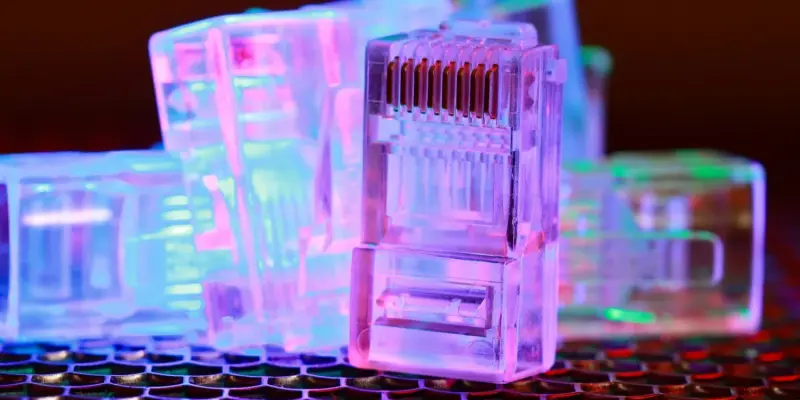In an era where Artificial Intelligence (AI) permeates almost every aspect of technology, the demand for high-performance, efficient networking infrastructure in data centers has never been more pressing. Traditional networking solutions, which once sufficed, now fall short in servicing the unique needs that AI workloads demand. DriveNets, an innovator in network solutions, has risen to this challenge by integrating its Network Cloud into AI data centers, effectively tackling the gaps in traditional Ethernet networks. This initiative reflects a marked shift within the industry towards accommodating the intense demands of AI, namely those related to bandwidth, latency, and the need for seamless data transmissions. As AI continues to evolve, the crucial role networking plays in facilitating its success cannot be understated.
AI Networking Challenges and the Shift to Ethernet
AI workloads present distinct challenges for traditional networking solutions, primarily demanding specific conditions where latency is minimized and packet delivery is impeccable. Traditional networks often fail to meet these rigorous performance standards, posing substantial hindrances to AI tasks like training and inferencing. Given these shortcomings, there’s been an industry-wide pivot towards better-suited networks. Despite the apparent limitations of Ethernet compared to specialized networks like InfiniBand, Ethernet’s open standards and extensive usage make it a preferred choice among IT leaders. InfiniBand, while technically superior in performance, faces hurdles such as vendor lock-in and a scant workforce acquainted with its management. These issues underline a growing preference for Ethernet, attributed to its broader familiarity and capacity for innovation in the AI sector. DriveNets steps into this scenario offering a pioneering solution designed to harness the benefits of Ethernet while overcoming its traditional deficiencies. By employing its ‘Fabric Scheduled Ethernet’ architecture, DriveNets aligns the low-latency and high-bandwidth benefits typically associated with InfiniBand, without the entanglements of vendor restrictions. The company’s approach, which blends conventional Ethernet client connections with a unique hardware-based, cell-based system, ensures predictable performance and meets the demands for lossless data transfer. This advancement is crucial, especially as AI data centers become more intricate and require scalable, adaptable network solutions that facilitate smooth operation without the need for drastic overhauls.
Disaggregated Model and Traffic Optimization
DriveNets’ disruptive approach in AI environments relies heavily on a disaggregated networking model, where traditional chassis-based switches are replaced by scalable fabric switches. This model leverages a top-of-rack configuration, which utilizes a cell-based protocol developed with Broadcom, allowing networks to expand horizontally as needs dictate. This disaggregated architecture introduces significant advantages: eliminating the necessity for comprehensive overhauls during expansions while avoiding vendor lock-in—a recurring issue in traditional models. DriveNets’ strategy empowers data centers to maintain flexibility, accommodating various technological advancements and adjustments with minimal friction.
Key to DriveNets’ innovation is its traffic optimization methodology, emphasizing virtual output queuing and ‘cell spraying.’ These techniques enable the meticulous distribution of network traffic, ensuring even dispersal and enhancing overall system efficiency. Virtual output queuing is particularly important, preventing head-of-line blocking, a common hindrance that could impede multiple tenants from utilizing shared infrastructure efficiently. ‘Cell spraying’ further bolsters network reliability by maintaining even traffic flow, crucial for AI operations that demand both high throughput and reliability. Collectively, these elements highlight DriveNets’ commitment to refining network infrastructure, making it more robust and adaptable for modern AI requirements.
DriveNets’ Solution and Industry Implications
The efforts by DriveNets to revolutionize AI networking embody several core advantages. Enhanced management of network resources, along with improved data sharing and collaboration capabilities, marks a significant trend towards more dynamic and integrated solutions. By offering network services on a subscription basis, DriveNets aligns with a broader industry trend of disaggregation and virtualization. This approach allows companies to select network stacks such as GPU, NIC, or DPU based on specific needs rather than being confined by networking hardware vendors’ restrictions. This flexibility proves pivotal as companies design AI clusters, fostering an environment where innovation and collaboration can thrive without traditional limitations.
DriveNets’ future projection is one where Ethernet, particularly its advanced forms such as Fabric Scheduled Ethernet, may gradually displace InfiniBand in AI data centers. Although InfiniBand currently holds performance advantages, its complex nature and proprietary ecosystem make it less appealing as scalability and flexibility become paramount. Ethernet’s simplicity and the adaptability it’s shown through DriveNets’ enhancements highlight its suitability for present and future AI demands. As AI progresses, the pursuit of simplified, vendor-neutral solutions becomes evident, culminating in a practical and robust networking architecture that can fluidly support AI advancements.
Looking Ahead in AI-Focused Networking
AI workloads demand stringent network conditions, primarily focusing on reduced latency and flawless packet delivery, posing challenges for traditional networking solutions. Such networks often fall short in meeting these rigorous requirements, hindering AI activities like training and inferencing. Due to these challenges, the industry is moving towards networks that better accommodate AI needs. InfiniBand, though superior in performance, suffers from vendor lock-in and limited expertise, whereas Ethernet, despite its shortcomings compared to InfiniBand, is favored by IT leaders due to its open standards and widespread use.
DriveNets offers a groundbreaking solution by leveraging Ethernet while mitigating its traditional limitations. With its ‘Fabric Scheduled Ethernet’ architecture, DriveNets combines the low-latency and high-bandwidth qualities of InfiniBand without vendor constraints. This approach integrates standard Ethernet connections with a specialized hardware-based system, ensuring consistent performance and lossless data transfer—crucial as AI data centers grow more complex, requiring scalable networks for efficient operations.

